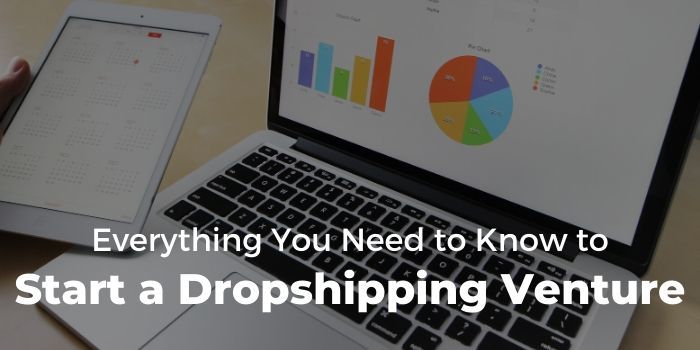An e-commerce entrepreneur who uses dropshipping sells products without having to carry inventory. In response to a customer's order, a store owner contacts the supplier, who will deliver the products directly to the customer. Dropshipping apps like Oberlo make it easy to start and run your own store. In this article, you’ll learn everything you need to know about dropshipping, from finding the perfect supplier to marketing your store.
There is no denying that dropshipping continues to grow at a ridiculously high pace and it is only a matter of time before it eliminates most of brick and mortar stores out there.
The whole procedure is pretty simple to understand. You operate as a middleman, receiving and fulfilling orders from customers and informing your suppliers about it.
So if you are really interested in learning more about dropshipping and giving it a go yourself, make sure to read until the end.

Did You Know?
- Market Size: As of the latest data, the global dropshipping market size is expected to reach USD 196.78 billion by 2022 (Grand View Research).
- Growth Projection: The dropshipping industry is projected to grow at a compound annual growth rate (CAGR) of 28.8% from 2019 to 2025 (Grand View Research).
- E-commerce Penetration: Dropshipping accounts for approximately 23% of online sales, according to a report by E-DSS.org.
- Entrepreneurial Interest: Over 27% of online retailers have adopted dropshipping as their primary method of order fulfillment (Forbes).
- Profit Margins: The average profit margin for dropshipping can vary widely, from 15% to 45%, depending on the niche and product pricing strategies (Shopify).
Easy To Start Means Everyone's Already Doing It
The competition in dropshipping is fierce. Because the barriers to entry are so low, anyone can start a dropshipping business. This means you're constantly competing with countless others, many of whom are selling the exact same products.
Standing out in such a saturated market requires a lot of effort, marketing savvy, and sometimes just plain luck. It's not just about having good products; it's about being able to get people to notice you in a sea of competitors, right?
Low Profit Margins
One of the biggest issues with dropshipping is the razor-thin profit margins. Since it's so easy to get started, the market is pretty crowded. This competition often leads to a race to the bottom with pricing. You've got to keep your prices low to attract customers, but this means you're making less money on each sale.
And let's not forget, the suppliers also need their cut. So, after you pay them and cover any other expenses, there's often not a lot left over for you. It can be a bit disheartening, right?
Lack of Control Over Inventory and Supply Chain
When you're dropshipping, the control over your inventory and supply chain is in someone else's hands. This can lead to a bunch of issues. If the supplier runs out of a product, you can't sell it. If they mess up an order, it's your reputation that takes the hit.
And then there's the shipping times. Products often take a long time to get to the customer, which can lead to frustration and complaints. It's a bit of a risky game, you see?
Customer Service Challenges
Here's a tricky part – customer service. When customers have problems, they come to you, not the supplier. But since you don't handle the shipping or manufacturing, solving these problems can be tough.
You might find yourself caught in the middle, trying to negotiate between unhappy customers and suppliers. It's a balancing act that can be really stressful and time-consuming, isn't it?
Branding Difficulties
Building a brand in the dropshipping world can be tough. Since you're selling products that other people are also selling, standing out isn't easy. Plus, you don't have much control over the packaging or branding of the products themselves.
This makes it hard to create a strong, recognizable brand that customers trust and return to. It's kind of like you're just another storefront selling the same stuff as everyone else, you know?
Did You Know?
- Top Categories: Electronics and fashion items are among the top categories for dropshipping, accounting for significant portions of the market (Statista).
- Customer Returns: The return rate for online purchases can be as high as 30%, with apparel and electronics seeing the highest return rates (Invesp).
- Supplier Challenges: About 24% of dropshippers cite finding and working with reliable suppliers as their biggest challenge (SaleHoo).
- Shipping Times: Long shipping times are a major customer complaint in dropshipping, with 18% of customers dissatisfied with delivery durations (Baymard Institute).
- Start-up Costs: Approximately 44% of dropshipping businesses start with less than $1,000, indicating low barriers to entry (BigCommerce).
Steps to Start Dropshipping
With that said, you know that dropshipping is a way to start an online business with little upfront investment. So here's a simple breakdown of the steps involved:
- Choose a Niche: Pick a product category that interests you and has a good demand. It's easier to sell products you're passionate about, you know?
- Research the Competition: See what others in your chosen niche are doing. This helps you understand the market and find ways to stand out.
- Find a Supplier: Look for reliable suppliers who can provide the products you want to sell. Websites like AliExpress or Oberlo are popular choices.
- Create a Business Plan: Sketch out how you want your business to run. Consider your target market, pricing strategy, and how you'll handle marketing.
- Set Up Your Online Store: You can use platforms like Shopify, WooCommerce, or Magento to create your store. They're user-friendly and offer plenty of help along the way, right?
- Organize Your Finances: Set up a system for tracking your income and expenses. This keeps you on top of your financial game.
- Create a Customer Service Plan: Decide how you'll handle customer inquiries and issues. Good customer service can really set you apart.
- Develop a Marketing Strategy: Plan how you'll attract customers to your store. Social media, SEO, and email marketing are good places to start, aren't they?
- Launch Your Store: Once everything's set up, launch your store to the public. Make sure to test everything works smoothly before going live.
- Analyze and Improve: Keep an eye on your sales and customer feedback. Use this info to tweak and improve your business as you go.
Problems You Can Solve
Simply picking a niche will not do, you know that, right? You need to look at a bigger picture and try to think of problems that people have right now and potential problems they might have in the future. Your business or, in this case, the product you are going to promote should be able to solve some of those issues.
If it does not, you will have a tough time scaling your business and turning it into a profitable and sustainable venture.
Did You Know?
- Success Rate: Only around 10% of dropshipping businesses become highly profitable, highlighting the competitive and challenging nature of the industry (Forbes).
- Impact of Reviews: Negative reviews due to issues like late delivery or product quality can affect more than 35% of potential sales (BrightLocal).
- Mobile Shopping: Over 50% of online shoppers use mobile devices, making mobile optimization crucial for dropshipping stores (OuterBox).
- Social Media Influence: Social media drives around 16% of online orders for dropshipping businesses, emphasizing the importance of social media marketing (BigCommerce).
- Customer Acquisition: The average cost of acquiring a new customer for an online store, including dropshipping businesses, can range from $20 to $50 (Neil Patel).
Exploit Amazon’s Weaknesses
If we consider Amazon's dominance in the market, it's clear that directly competing with them on common products is an impossible game, isn't it?
So finding out things that Amazon doesn't do may be your survival tactic for dropshipping businesses. Here’s how this could play out.
Short-Term Trends
Amazon is big, and sometimes, that means it can be a little slow in catching up with the latest fads. You know, those trends that pop up overnight and everyone suddenly wants a piece of? Think about things like fidget spinners or viral game merchandise. They can be all the rage one moment and gone the next.
For a smaller business, this is a sweet spot. You can quickly jump on these trends, source the products, and get them to your customers while the trend is still hot. Amazon, with its huge inventory and complex supply chains, might not react as fast. This quick action can really make a difference, right?
Customization and Personalization
Here's a thing about Amazon – it sells products, but it doesn't really personalize them. If you're into custom-made or personalized items, this is your arena. There are wholesalers that manufacture custom-made products; t-shirts, personalized gifts, or made-to-order furniture. So you can drop-ship these items.
When you offer these kinds of products, you're offering a unique experience, right? People love having something that's made just for them or that they can give as a special gift. Amazon's model isn't set up for this kind of personal touch. That's where you come in, you see?
Local and Cultural Products
Amazon tries to cater to everyone, which sometimes means they miss out on local or cultural specifics. This is where you have an edge. Focusing on products that have a local flavor or are specific to a certain culture can be a great strategy.
For example, local artisan crafts, regional food items, or products that cater to specific cultural celebrations can be a hit. These are items that people look for, but can't always find on a big platform like Amazon. By providing these, you're not just selling products; you're connecting with customers on a more personal level, you know?
Building a Community
Amazon is a marketplace, but it's not really a community. If you can build a community around your dropshipping brand, you're onto something special. This can be through social media, forums, or even local events.
When people feel part of a community, they're more likely to be loyal customers. They're not just buying a product; they're joining a group of like-minded people. This kind of loyalty and engagement is something Amazon can't easily replicate. Building a community takes time and effort, but it's worth it, isn't it?
Picking the right supplier is one of the most difficult things. You can never be certain of anyone, so in this case, the best thing you can do is spend time researching. Look through reviews and gather as much intel as you can before you commit.
Did You Know?
- E-commerce Returns: The average return rate for e-commerce businesses, including dropshipping, is between 20% and 30%, significantly higher than for brick-and-mortar stores (National Retail Federation).
- Automation Tools: Over 60% of dropshipping businesses use automation tools for tasks like order processing and inventory management (McKinsey & Company).
- Global Reach: Dropshipping allows retailers to offer products to customers worldwide, with international sales making up over 25% of total sales for some stores (Shopify).
- Niche Markets: Successful dropshipping businesses often focus on niche markets, with niche products accounting for up to 40% of online sales (BigCommerce).
- Environmental Impact: With dropshipping, the carbon footprint can be reduced by up to 50% compared to traditional retail models, due to more direct shipping routes and less need for inventory storage (Journal of Cleaner Production).
User-Friendly Website
The website is the cornerstone of your business and you need to work really hard to make it as best as you can. It should be user-friendly, meaning that the UI and other aspects are running smoothly. Also, do not forget the importance of mobile optimization.
Marketing and Traffic

Expecting to make money from nothing would be foolish. Marketing is a thing that will require most of your work.
There are a lot of ways to go about this, but most people tend to focus on two things – search engine optimization and social media.
The former is quite clear as it allows you to receive organic traffic from search engines. And people who come from there have intent to buy because they enter very particular keywords when googling.
As for social media, it also has a clear use. The most popular platforms have hundreds of millions of active users. And if you could take advantage of that, you can certainly expect to make a lot of money.
How Do I Find The Right Niche?
You can check Google Trends to see what's popular. Look for something that's trending upward but isn't everywhere yet. That's one way. But you can also check Instagram or Reddit to see what people are talking about.
- Follow Hashtags: Look for hashtags related to your potential niche. For example, if you're interested in eco-friendly products, you might follow hashtags like #EcoFriendlyLiving or #SustainableProducts.
- Check Influencers: Influencers in your niche can be a goldmine for trends. See what products they're using or promoting.
- Look at Comments: Sometimes, the comments on popular posts can give you insights into what people are looking for or the problems they have with current products.
- Find Relevant Subreddits: There are communities (subreddits) for almost every interest on Reddit. Join those related to your niche and see what's being discussed.
- Read the Discussions: People often post about their experiences with products, their frustrations, and what they wish was better. This can be valuable info for identifying product opportunities.
- Ask Questions: You can even directly ask for opinions on what kind of products people wish they had or issues they face with current products in the market.
Choose The "Right" Suppliers?
Finding suppliers on platforms like AliExpress or SaleHoo is pretty straightforward, and yes, they provide you with the information you need to make an informed choice. Here's how you go about it:
AliExpress
Search for Products: Start by searching for the type of product you want to sell. Use the search bar and try different keywords.
Check Supplier Ratings and Reviews: For each product, look at the supplier's ratings and customer reviews. This feedback gives you an idea of the supplier's reliability and product quality.
Review Product Details: Pay close attention to the product details, including price, shipping options, and estimated delivery times.
Contact the Supplier: If you're interested in a product, don't hesitate to contact the supplier. Ask them about minimum order quantities, shipping times, and return policies. Good communication is key.
Order Samples: Before making a large order, it's wise to order a sample. This way, you can check the product quality and shipping speed firsthand.
SaleHoo
Use the Directory: SaleHoo offers a curated directory of suppliers. You can search by product category or market (like dropshipping).
Review Supplier Information: Each supplier on SaleHoo has a profile with important information like their product range, quality, and customer service history.
Use SaleHoo's Research Tools: SaleHoo provides tools to research trends and products. This can help you decide what products might be good to sell.
Contact Suppliers: Once you find a potential supplier, reach out to them directly through SaleHoo. Ask about their products, pricing, and terms.
Verify and Test: As with AliExpress, it's a good idea to order samples and verify the supplier's reliability.
Both platforms are designed to make it as easy as possible for you to find and vet suppliers.
Questions
1. What's the first step in starting a drop-shipping business?
- A) Negotiate with aliens for intergalactic shipping rates.
- B) Build a warehouse on the moon.
- C) Summon a genie to find suppliers.
- D) Create an underwater delivery service with mermaids.
2. How do you find a reliable supplier?
- A) Challenge them to a dance-off.
- B) Consult a magic 8-ball.
- C) Host a supplier talent show.
- D) Use carrier pigeons to send RFPs.
3. What's the best way to handle shipping delays?
- A) Hire time travelers.
- B) Use teleportation devices.
- C) Partner with Santa's sleigh.
- D) Develop a wormhole courier service.
4. How do you ensure product quality?
- A) Test products in zero gravity.
- B) Have a psychic predict customer satisfaction.
- C) Use a truth serum on suppliers.
- D) Conduct underwater product testing.
5. What's the key to successful customer service?
- A) Train a team of talking parrots.
- B) Employ mind readers for instant problem solving.
- C) Use smoke signals for customer notifications.
- D) Establish a hotline to the North Pole.
6. How should you market your drop-shipping store?
- A) Skywriting by dragons.
- B) Subliminal messages in pop songs.
- C) Launch a satellite for space billboards.
- D) Invent a social media platform for pets.
7. What's the best way to optimize your website?
- A) Make it only accessible by secret handshake.
- B) Use ancient runes for the code.
- C) Have it load only on full moons.
- D) Require a magic spell to enter.
8. How do you manage returns?
- A) Appoint a council of wise owls.
- B) Use a time machine to prevent the purchase.
- C) Open a portal to an alternate universe.
- D) Offer exchanges with items from Atlantis.
9. What's the ultimate goal of drop-shipping?
- A) Achieve world domination through logistics.
- B) Build a castle made of returned products.
- C) Fund an expedition to find El Dorado.
- D) Start a new civilization on Mars.
10. How do you scale your business?
- A) Clone yourself.
- B) Train an army of robots.
- C) Convince mermaids to sell underwater.
- D) Use a growth potion from a witch.
Advice
1. For Starting a Drop-Shipping Business
- A) Always have a universal translator handy; alien languages can be tricky.
- B) Moon real estate is skyrocketing, so secure your plot early.
- C) Genies are tricky; always read the fine print of your three wishes.
- D) Negotiate good rates with the mermaids; they drive a hard bargain.
2. Finding a Reliable Supplier
- A) Make sure you have killer dance moves; you want to impress, not depress.
- B) Keep shaking until you get the answer you want; persistence is key.
- C) Talent shows need a good panel; recruit judges from the animal kingdom for fairness.
- D) Pigeons might get distracted; include breadcrumbs with your RFPs to ensure delivery.
3. Handling Shipping Delays
- A) Stock up on plutonium for your time machine; it's always running out at the worst moments.
- B) Teleportation can scramble things; label items clearly to avoid mixed-up deliveries.
- C) Santa's busy; draft a compelling letter to secure his off-season services.
- D) Wormhole insurance is a must; things can get lost in transit.
4. Ensuring Product Quality
- A) Zero gravity testing facilities are pricey; start a crowdfunding campaign.
- B) Psychics have busy schedules; book your session well in advance.
- C) Truth serums work best with a dash of lemon; it enhances the truthiness.
- D) Waterproof everything; you never know how deep it'll go.
5. Successful Customer Service
- A) Parrots repeat everything; avoid teaching them any colorful language.
- B) Mind readers are sensitive; think happy thoughts during interviews.
- C) Smoke signals are weather-dependent; have a backup communication plan.
- D) Elves answer the North Pole hotline; cookies are a great bribe.
6. Marketing Your Store
- A) Hire a dragon with precision flying; you want your message clear, not scorched.
- B) Copyright your subliminal messages; it's your intellectual property.
- C) Space billboards are the future; start designing yours in low-Earth orbit.
- D) Pets are influencers too; cater to the feline audience for quick shares.
7. Optimizing Your Website
- A) Secret handshakes require tutorials; consider YouTube for wider reach.
- B) Runes are complex; hire a Viking coder for authenticity.
- C) Lunar power is unreliable; have a solar backup for cloudy nights.
- D) Magic spells need maintenance; keep a wizard on retainer.
8. Managing Returns
- A) Wise owls are hard to find; a hat and glasses often suffice.
- B) Time machines are a logistical nightmare; double-check your coordinates.
- C) Alternate universes have customs fees; budget accordingly.
- D) Atlantis exchanges are waterlogged; invest in a good dehumidifier.
9. Ultimate Goal of Drop-Shipping
- A) World domination requires a good map; don't skimp on the GPS.
- B) Castles need zoning permits; check with your local dragon lord.
- C) El Dorado is elusive; pack snacks for the journey.
- D) Mars needs terraforming; start with a small greenhouse.
10. Scaling Your Business
- A) Cloning ethics are murky; consult your conscience (and lawyer).
- B) Robot armies need updates; schedule regular downtime.
- C) Mermaids unionize quickly; offer competitive shells.
- D) Growth potions are volatile; always measure twice, pour once.
Can You Really Start a Dropshipping Venture?
It's definitely possible, of course. But it's a crowded space, and standing out isn't easy. Many people jump into dropshipping thinking it'll be a quick way to make money, but it often takes more than just setting up a store and waiting for the sales to roll in.
To succeed, you need to be smart about your niche, savvy with your marketing, and exceptional in customer service. Plus, staying updated with market trends and continuously adapting your strategy. It's about creating a unique brand and experience that draws customers in and keeps them coming back.
Sure, it's challenging, and success might not come overnight, but with persistence and a well-thought-out approach, making your mark in the dropshipping world is within reach, you know?






